620 lines
20 KiB
Markdown
620 lines
20 KiB
Markdown
1. [Overview](#1-overview)
|
|
2. [Features](#2-features)
|
|
3. [Installation](#3-installation)
|
|
4. [Configuration](#4-configuration)
|
|
5. [The API](#5-the-api)
|
|
6. [DynDNS](#6-dyndns)
|
|
7. [Conclusion](#7-conclusion)
|
|
|
|
Don't use this code right now.
|
|
Use the latest release instead.
|
|
|
|
|
|
NOTICE: This documentation is not current as of September 2022.
|
|
After I finished the refactoring I'll upgrade it.
|
|
|
|
<a name="overview"></a>
|
|
# 1. Overview
|
|
|
|
This package provides an API for the Bind nameserver.
|
|
It consists of two parts, the API itself and a CLI tool to configure the available functions.
|
|
|
|
|
|
<a name="features"></a>
|
|
# 2. Features
|
|
|
|
## 2.1. CLI
|
|
|
|
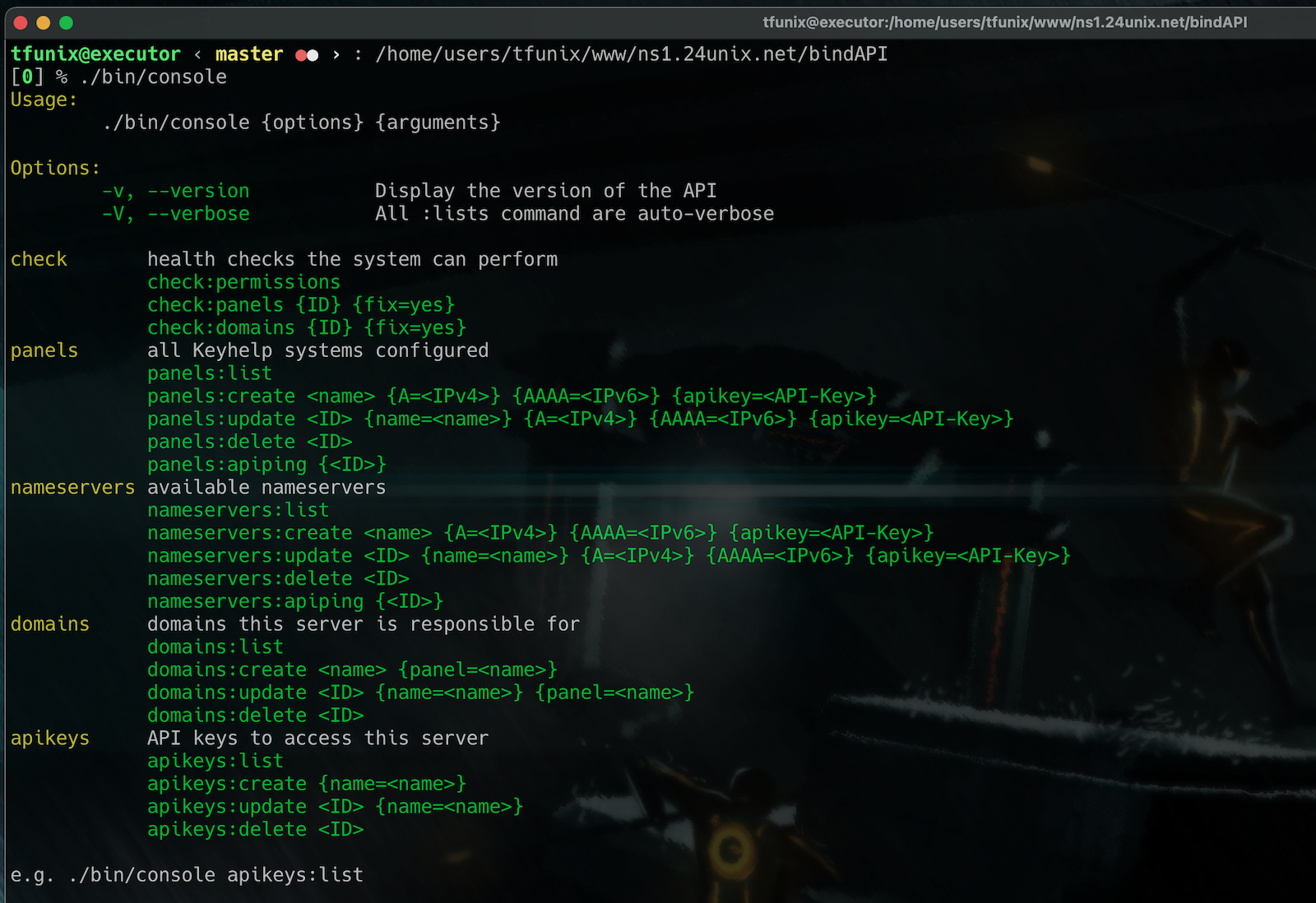
|
|
|
|
The CLI is used to perform configuration and some checks:
|
|
|
|
* check
|
|
- Permissions: The API needs to be able to access some files and create new ones
|
|
- Panels: This checks one or all panels if every nameserver is aware of all domains
|
|
- Domain: Check is all support files for domains on this NS are existing
|
|
* panels
|
|
- List: List all panels which are configured on this server
|
|
- Create: Adds a new panel to the configuration
|
|
- Update: Changes one or more parameters of the panel
|
|
- Delete: Deletes the given panel
|
|
- ApiPing: Calls the /ping endpoint of the given server or all if no Panel is specified
|
|
- some additional API call might be added
|
|
* nameservers
|
|
- similar to panels, but for the nameservers
|
|
* domains
|
|
- similar usage to panels/domains, manage all slave zones
|
|
* apikeys
|
|
- manage the keys to access this nameserver via API
|
|
|
|
## 2.2. API
|
|
|
|
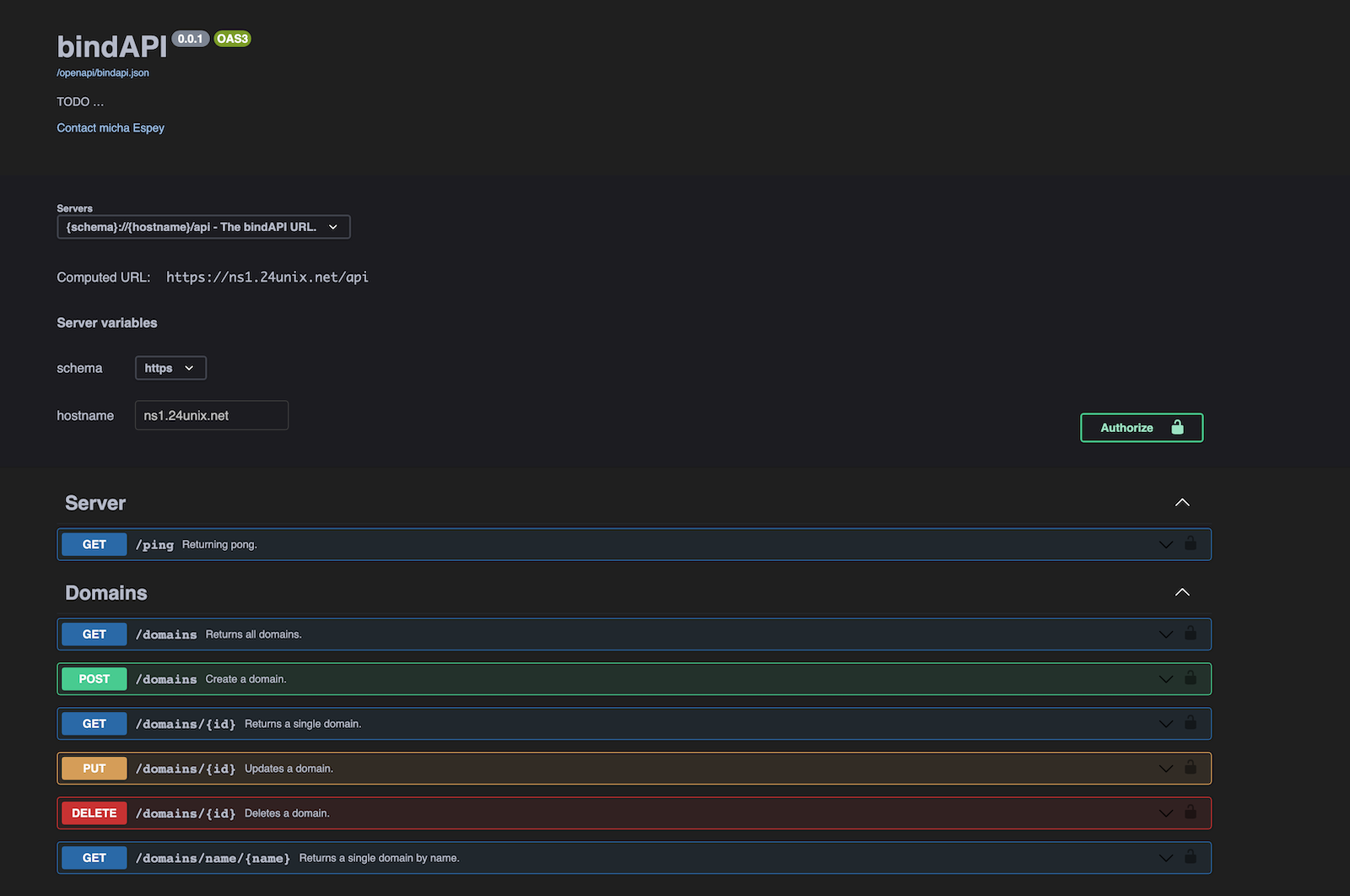
|
|
|
|
The API is a RESTful API, there is a self explaining Swagger/OpenAPI available.
|
|
|
|
<a name="installation"></a>
|
|
# 3. Installation
|
|
|
|
You can install the bindAPI on either a standalone server or an existing KeyHelp Panel. However, slave zones are only managed for masters which lie on Keyhelp panels.
|
|
|
|
## 3.1. Installation on a KeyHelp panel
|
|
|
|
In KeyHelp, install PHP 8.1.
|
|
This is mandatory, the API relies on features only available since PHP 8.0.
|
|
It might run on PHP 8.0 but has not been tested as there is no reason not to install PHP 8.1.
|
|
|
|
So head over to:
|
|
Settings => Configuration => Feature Settings => PHP Interpreter
|
|
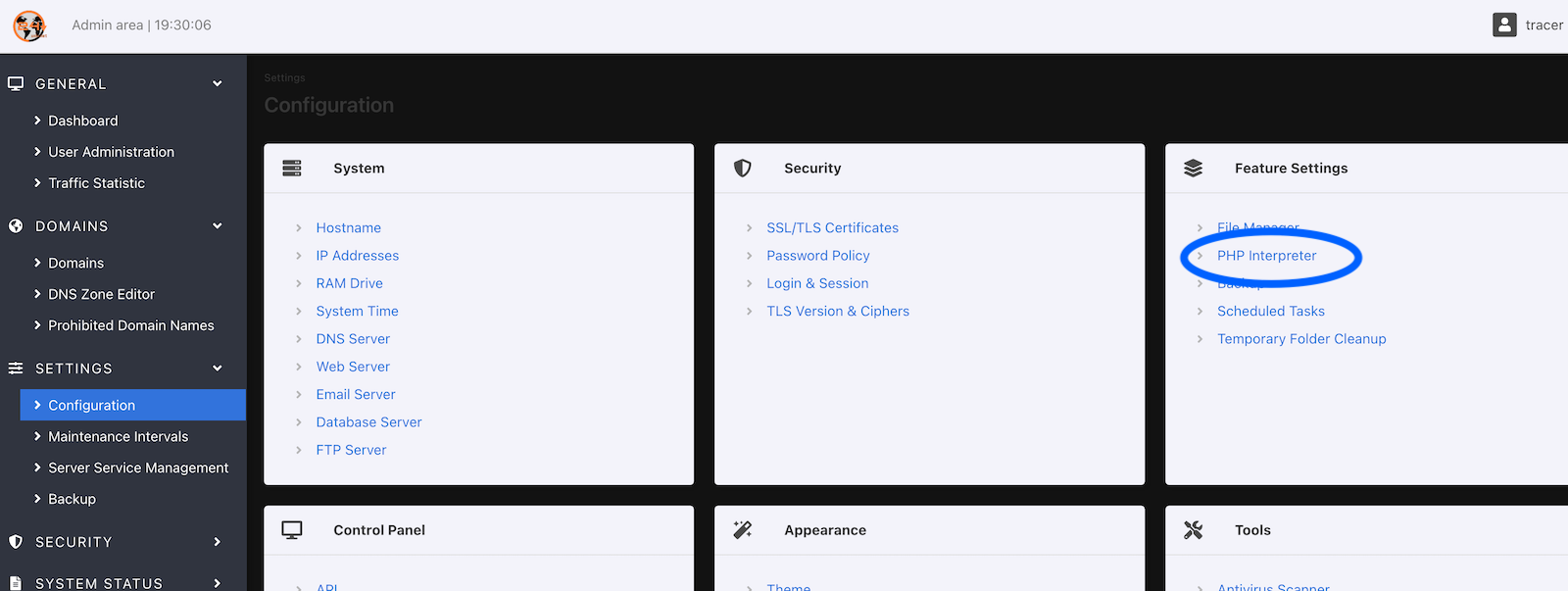
|
|
|
|
|
|
Set the checkmark and press Save.
|
|
|
|
Wait about a minute, the installation is started via a cronjob which runs every minute.
|
|
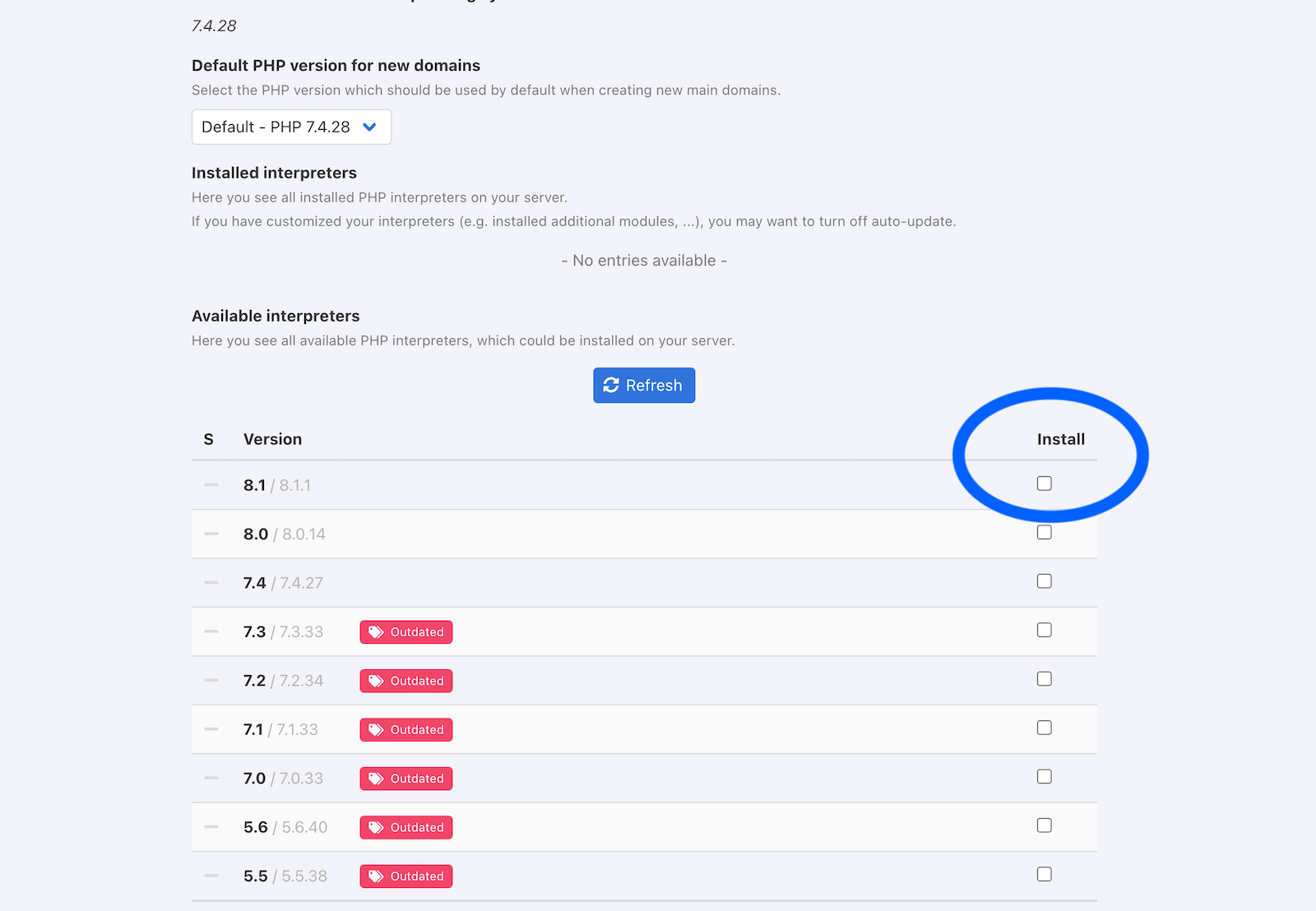
|
|
|
|
Now you see the newly installed PHP interpreters:
|
|
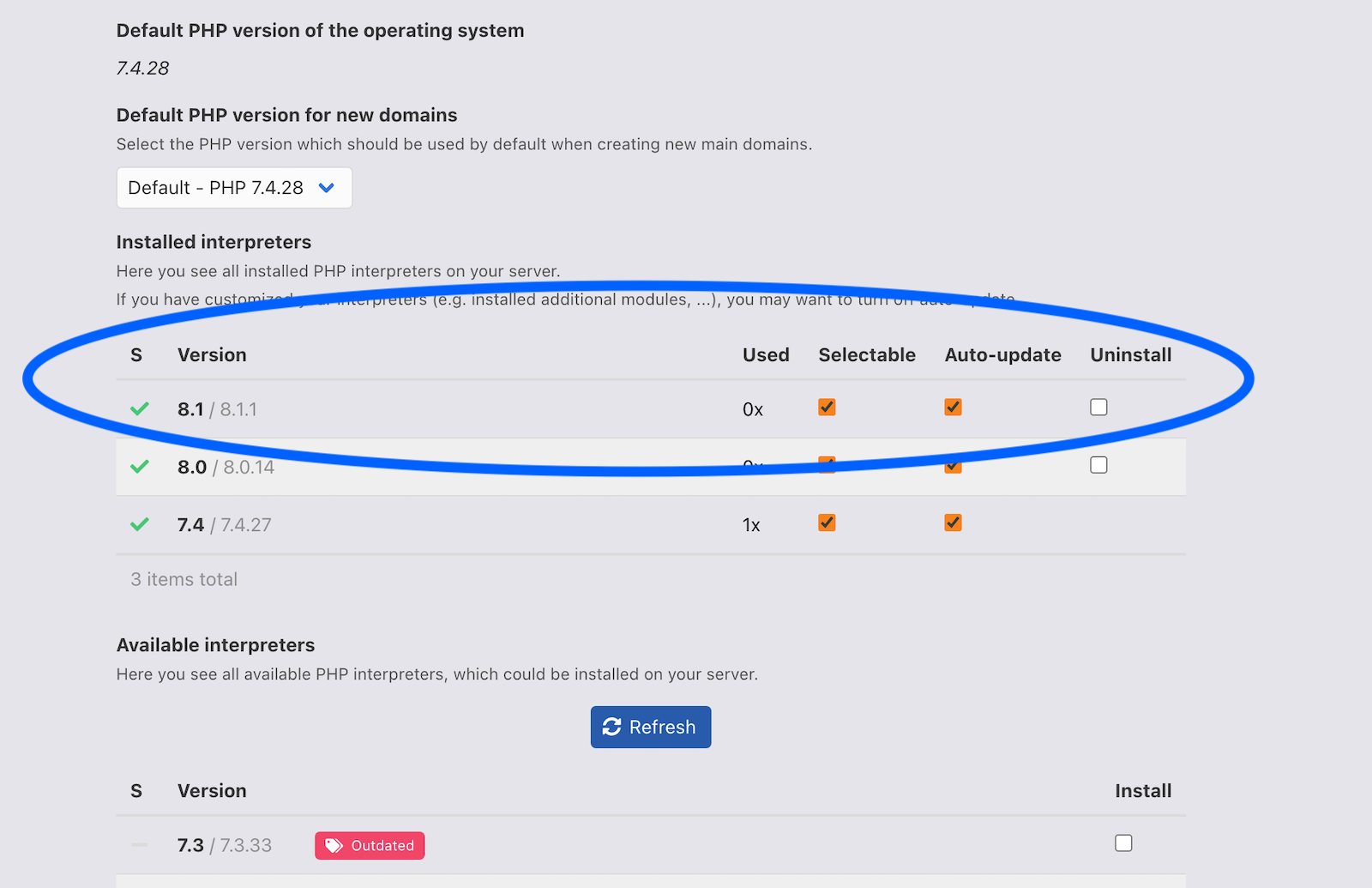
|
|
|
|
Next create a domain, e.g. ns1.24unix.net:
|
|
|
|

|
|
|
|
I created the domain in ns1.24unix.net below the /www folder.
|
|
|
|
We'll change the base directory later.
|
|
|
|
Now we need to log into our server, using e.g. iTerm2 or under Linux whichever terminal you prefer.
|
|
|
|
As root (or via sudo):
|
|
|
|
`apt install git wget`
|
|
|
|
We need this to check out the bindAPi from git later.
|
|
|
|
So as we are still root, we need to install composer, two reasonable locations are under ~/bindAPI/bin or /usr/local/bin.
|
|
(~ stands for the home folder)
|
|
Here I will install it under /usr/local/bin, in the example with the standalone server I'll install it under /bindAPI/bin.
|
|
|
|
`wget https://getcomposer.org/installer`
|
|
|
|
`php installer --install-dir=/usr/local/bin --filename=composer`
|
|
|
|
Now we can change into our new user, remind to give him shell access in the panel.
|
|
|
|
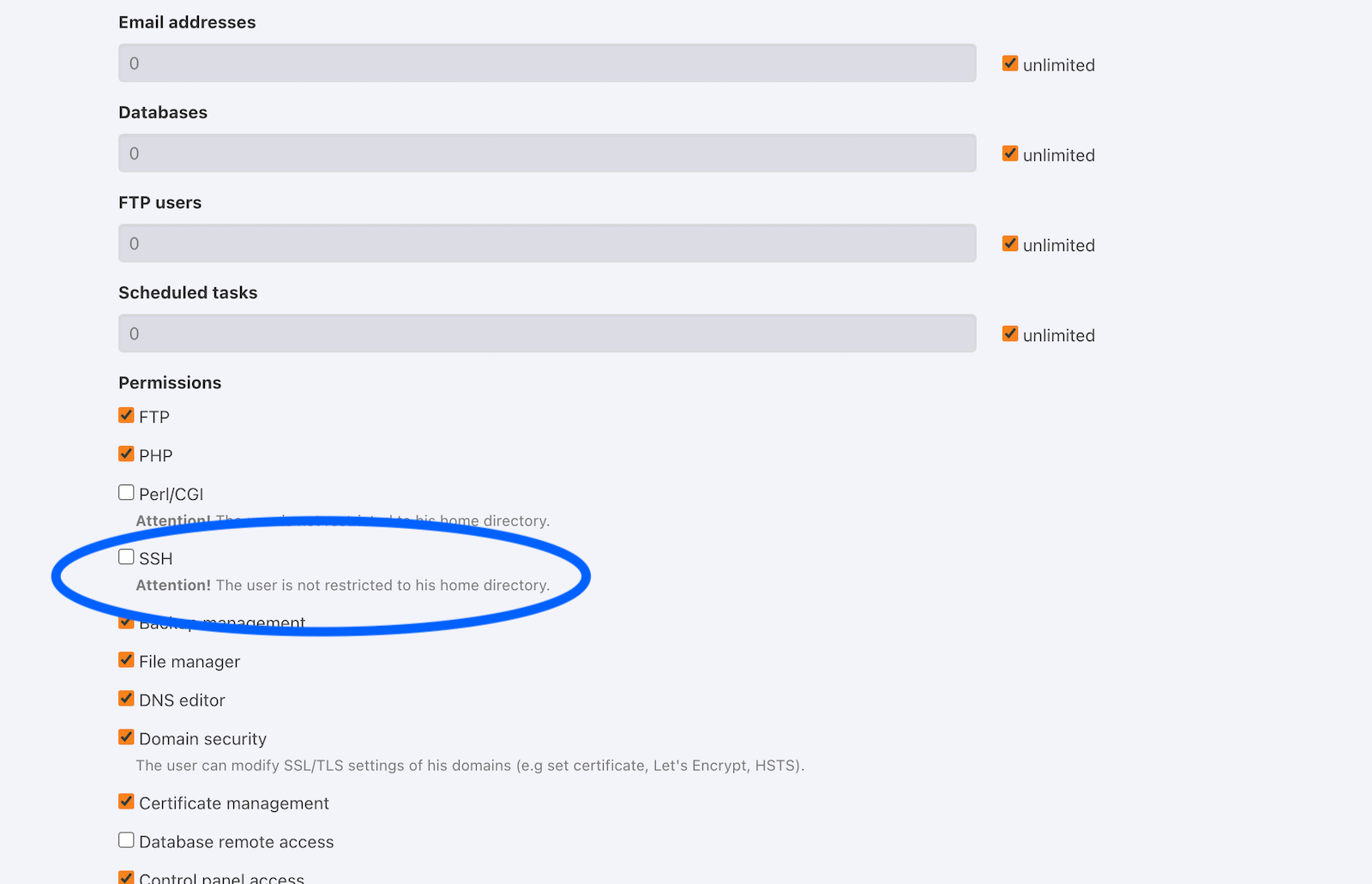
|
|
|
|
`su - tfunix`
|
|
|
|
|
|
In my example I assume the user is called tfunix, his home points to /home/users/tfunix.
|
|
|
|
Base directory for the bindAPI is ~/www/ns1.24unix.net/bindApi.
|
|
|
|
So, we head over to our directory:
|
|
|
|
`cd www/ns1.24unix.net/bindAPI`
|
|
|
|
Remove the defaults files:
|
|
|
|
`rm *`
|
|
|
|
Next, we'll need to fetch the bindAPI. As of now, the latest release is 1.0.1:
|
|
https://git.24unix.net/tracer/bindAPI/archive/1.0.1.tar.gz
|
|
|
|
I'd suggest checking here for the latest version:
|
|
https://git.24unix.net/tracer/bindAPI/releases
|
|
|
|
Or just use git to check out the latest update:
|
|
|
|
```
|
|
git clone https://git.24unix.net/tracer/bindAPI.git
|
|
Cloning into 'bindAPI'...
|
|
remote: Enumerating objects: 878, done.
|
|
remote: Counting objects: 100% (878/878), done.
|
|
remote: Compressing objects: 100% (670/670), done.
|
|
remote: Total 878 (delta 510), reused 225 (delta 139), pack-reused 0
|
|
Receiving objects: 100% (878/878), 3.25 MiB | 4.46 MiB/s, done.
|
|
Resolving deltas: 100% (510/510), done.
|
|
```
|
|
|
|
We need to pull the dependencies for composer:
|
|
|
|
`/usr/bin/keyhelp-php81 /usr/local/bin/composer update`
|
|
|
|
You might notice a quite strange command. We need to call php with full path, and explicitly the 8.1 version. KeyHelp
|
|
relies on the default PHP installation, so the php binary will always point to 7.4 when you're on Debian Bullseye.
|
|
|
|
So, in bin/console the path to /usr/bin/keyhelp-php81 is hardcoded after the shebang, a step we have to remind if we
|
|
install the standalone version.
|
|
|
|
Now make the CLI executable:
|
|
|
|
`chmod +x bin/console`
|
|
|
|
And give it a try:
|
|
|
|
```
|
|
% ./bin/console
|
|
Missing config file
|
|
Should I create a new config based on config.json.sample? (y/N): n
|
|
You first have to setup the bindAPI. Bye.
|
|
```
|
|
|
|
So now we can head back to our panel and set the Document root to /home/users/tfunix/ns1.24unix.net/bindAPI/public.
|
|
|
|
Additionally, we have to change the open_basedir directive:
|
|
|
|
`##DOCROOT##/www:##DOCROOT##/files:##DOCROOT##/tmp:/etc/bind:/etc/bind/local.zones`
|
|
|
|
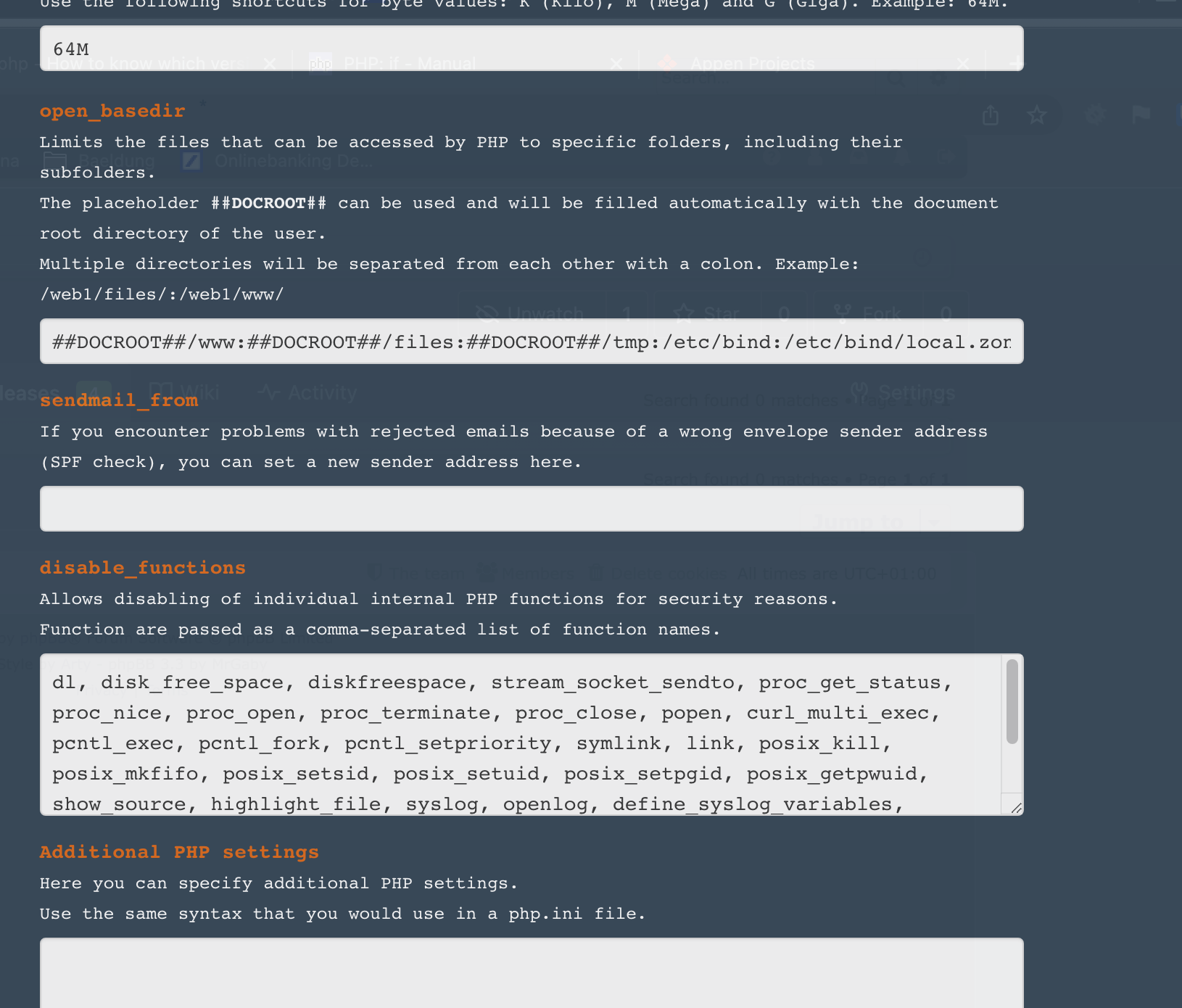
|
|
|
|
and remove exec from disabled functions.
|
|
|
|
OK, we are finished with the installation and head over to the [4. Configuration](#4-configuration).
|
|
|
|
## 3.2. Installation on a plain Debian Bullseye
|
|
|
|
So, at first you should read and understand all steps in 3.1, as we will learn only the differences.
|
|
|
|
We assume that you're on a fresh minimal installation.
|
|
|
|
You need at first to pull some essentials:
|
|
|
|
`apt install git vim wget zsh`
|
|
|
|
To get access to all flavors of PHP sury.org is the perfect match, he's also the official maintainer für the Debian PHP packages (and Ubuntu, as anyone would care).
|
|
|
|
Execute this commands:
|
|
|
|
```apt -y install apt-transport-https lsb-release ca-certificates curl
|
|
wget -O /etc/apt/trusted.gpg.d/php.gpg https://packages.sury.org/php/apt.gpg
|
|
echo "deb https://packages.sury.org/php/ $(lsb_release -sc) main" > /etc/apt/sources.list.d/php.list
|
|
apt update
|
|
```
|
|
We need at least php-fpm, php-cli, and besides that php-curl, php-xml and php-mbstring:
|
|
|
|
`apt install ph8.1-fpm, php8.1-cli php8.1-curl php8.1-xml php8.1-mbstring`
|
|
|
|
So, to be compatible with KeyHelp, we create a symlink:
|
|
|
|
`ln -s /usr/bin/php /usr/bin/keyhelp-php81`
|
|
|
|
We also need MariaDB, the successor of MySQL.
|
|
(Maria is the second daughter of Michael Widenius, guess what, his first is named My.
|
|
So MySQL and MariaDB even makes more sense ^^)
|
|
|
|
`apt install mysql`
|
|
|
|
And, we need the webserver, of course:
|
|
|
|
`apt install apache2 libapache-mod-fcgid php8.1-fpm`
|
|
|
|
And enable fpm support:
|
|
|
|
`a2econf php8.1-fpm`
|
|
|
|
Disable the default site:
|
|
|
|
`a2dissite 000*`
|
|
|
|
```
|
|
<VirtualHost *:80>
|
|
ServerName ns1.24unix.net
|
|
ServerAdmin tracer@24unix.net
|
|
DocumentRoot /var/www/html
|
|
ErrorLog ${APACHE_LOG_DIR}/ns1.24unix.net/error.log
|
|
CustomLog ${APACHE_LOG_DIR}/ns1.24unix.net/access.log combined
|
|
|
|
RewriteEngine on
|
|
RewriteCond %{SERVER_NAME} =ns1.24unix.net
|
|
RewriteRule ^ https://%{SERVER_NAME}%{REQUEST_URI} [END,NE,R=permanent]
|
|
</VirtualHost>
|
|
```
|
|
|
|
```
|
|
<IfModule mod_ssl.c>
|
|
<VirtualHost *:443>
|
|
ServerName ns1.24unix.net
|
|
ServerAdmin tracer@24unix.net
|
|
Protocols h2 h2c http/1.1
|
|
DocumentRoot /var/www/html/bindAPI/public
|
|
ErrorLog ${APACHE_LOG_DIR}/ns1.24unix.net/error.log
|
|
CustomLog ${APACHE_LOG_DIR}/ns1.24unix.net/access.log combined
|
|
SSLCertificateFile /etc/letsencrypt/live/ns1.24unix.net/fullchain.pem
|
|
SSLCertificateKeyFile /etc/letsencrypt/live/ns1.24unix.net/privkey.pem
|
|
Include /etc/letsencrypt/options-ssl-apache.conf
|
|
<FilesMatch \.php$>
|
|
SetHandler "proxy:unix:/run/php/php8.1-fpm.sock|fcgi://localhost"
|
|
</FilesMatch>
|
|
<Directory /var/www/html/bindAPI/public>
|
|
Options -Indexes +FollowSymLinks +MultiViews
|
|
AllowOverride All
|
|
Require all granted
|
|
</Directory>
|
|
|
|
</VirtualHost>
|
|
</IfModule>
|
|
```
|
|
|
|
php installer --install-dir=./bin/ TODO
|
|
|
|
/usr/bin/keyhelp-php81 bin/composer.phar update
|
|
|
|
|
|
<a name="configuration"></a>
|
|
# 4. Configuration
|
|
|
|
So, another call of our binary, this time we agree to get a config written:
|
|
|
|
```
|
|
# ./bin/console
|
|
Missing config file
|
|
Should I create a new config based on config.json.sample? (y/N): y
|
|
Config file has been generated. Adjust it to your needs, then proceed to database setup.
|
|
```
|
|
|
|
So, what's in it?
|
|
|
|
```
|
|
cat config.json
|
|
{
|
|
"dbHost": "localhost",
|
|
"dbPort": 3306,
|
|
"dbDatabase": "sampledb",
|
|
"dbUser": "sampleuser",
|
|
"dbPassword": "secret",
|
|
"debug": false
|
|
}
|
|
```
|
|
We'll start the installer another time:
|
|
|
|
```
|
|
$ ./bin/console
|
|
SQLSTATE[HY000] [1698] Access denied for user 'sampleuser'@'localhost'
|
|
Did you create the database and adjust the config file?
|
|
|
|
You can create database an user via a panel or manually in mysql shell:
|
|
Created an initial password: T6BpmtNk
|
|
CREATE DATABASE bindAPI;
|
|
CREATE USER 'bindAPI'@'localhost' IDENTIFIED BY 'T6BpmtNk';
|
|
GRANT SELECT, INSERT, UPDATE, DELETE, CREATE, INDEX, DROP, ALTER, CREATE TEMPORARY TABLES, LOCK TABLES ON bindAPI.* TO 'bindAPI'@'localhost';
|
|
There is no need to run FLUSH PRIVILEGES when using GRANT!
|
|
```
|
|
|
|
So, now it offers us the SQL statements to create a new user and database and set permissions. If were on plain debian,
|
|
we just can copy and paste (the password is random) this as root into mysql.
|
|
|
|
If we're using the panel, lets create a database and write down the credentials and update config.json.
|
|
|
|
And another call to the console:
|
|
|
|
```
|
|
$ ./bin/console
|
|
Error: Cannot find tables.
|
|
Should I try to create them? (y/N): y
|
|
Tables have been created.
|
|
```
|
|
|
|
When we now call the console it displays its options:
|
|
|
|

|
|
|
|
|
|
Now we can finally begin to populate our configuration.
|
|
|
|
We assume ns1 and ns2 are already configured, so we add them to the local config:
|
|
|
|
```
|
|
$ ./bin/console nameservers:create ns1.24unix.net a=176.9.165.128 aaaa=2a01:4f8:161:12cd::128 apikey=61f27a57c9d1f.[truncated]
|
|
Nameserver ns1.24unix.net has been created with id 1
|
|
|
|
```
|
|
|
|
And the same procedure for ns2, and now we have:
|
|
|
|
```
|
|
$ ./bin/console nameservers:list
|
|
All available nameservers:
|
|
+------+------------------+------------------+---------------------------------------+-----------------+
|
|
| ID | Name | A | AAAA | API Key |
|
|
+------+------------------+------------------+---------------------------------------+-----------------+
|
|
| 1 | ns1.24unix.net | 176.9.165.128 | 2a01:4f8:161:12cd::128 | 61f27a57c9d1f |
|
|
| 2 | ns2.24unix.net | 37.120.185.117 | 2a03:4000:f:5e2:a80c:2dff:fed1:e109 | 61eef211dea9a |
|
|
+------+------------------+------------------+---------------------------------------+-----------------+
|
|
```
|
|
Now we can ping the API to check if our servers are alive.
|
|
We have to add --verbose to the command, because it can also be used to monitor the server in cron jobs where no output is desired, only the result code.
|
|
|
|
```
|
|
$ ./bin/console --verbose nameservers:apiping
|
|
ns1.24unix.net 176.9.165.128 pong 2a01:4f8:161:12cd::128 pong
|
|
ns2.24unix.net 37.120.185.117 pong 2a03:4000:f:5e2:a80c:2dff:fed1:e109 pong
|
|
```
|
|
|
|
Now we can add all our panels:
|
|
|
|
```
|
|
$ ./bin/console panels:create executor.24unix.net a=176.9.165.128 aaaa=2a01:4f8:161:12cd::128 apikey=Lo7jsXYQ.[truncated]
|
|
Panel executor.24unix.net has been created with id 28
|
|
```
|
|
|
|
Oups. The autoincrement ID should be 1, I'll fix that.
|
|
|
|
OK, now we've got all our panels:
|
|
|
|
```
|
|
$ ./bin/console panels:list
|
|
All available panels:
|
|
+------+--------------------------+------------------+---------------------------------------+------------+
|
|
| ID | Name | A | AAAA | API Key |
|
|
+------+--------------------------+------------------+---------------------------------------+------------+
|
|
| 28 | executor.24unix.net | 176.9.165.128 | 2a01:4f8:161:12cd::128 | Lo7jsXYQ |
|
|
| 33 | imperial.24unix.net | 176.9.165.130 | 2a01:4f8:161:12cd::130 | AFB0Gm7C |
|
|
| 32 | interdictor.24unix.net | 176.9.165.131 | 2a01:4f8:161:12cd::131 | qsrlTNIu |
|
|
| 31 | paz.24unix.net | 176.9.165.134 | 2a01:4f8:161:12cd::134 | DquWO8vf |
|
|
| 29 | shadow.24unix.net | 37.120.185.117 | 2a03:4000:f:5e2:a80c:2dff:fed1:e109 | o2CtvTQh |
|
|
| 30 | tector.24unix.net | 176.9.165.137 | 2a01:4f8:161:12cd::137 | HJwrfMd7 |
|
|
+------+--------------------------+------------------+---------------------------------------+------------+
|
|
```
|
|
|
|
Look if they're alive:
|
|
|
|
```
|
|
$ ./bin/console --verbose panels:apiping
|
|
executor.24unix.net 176.9.165.128 pong 2a01:4f8:161:12cd::128 pong
|
|
imperial.24unix.net 176.9.165.130 pong 2a01:4f8:161:12cd::130 pong
|
|
interdictor.24unix.net 176.9.165.131 pong 2a01:4f8:161:12cd::131 pong
|
|
paz.24unix.net 176.9.165.134 pong 2a01:4f8:161:12cd::134 pong
|
|
shadow.24unix.net 37.120.185.117 pong 2a03:4000:f:5e2:a80c:2dff:fed1:e109 pong
|
|
tector.24unix.net 176.9.165.137 pong 2a01:4f8:161:12cd::137 pong
|
|
```
|
|
|
|
OK, Nameservers ✅
|
|
Panels ✅
|
|
|
|
What's next? Check the domains on each panel:
|
|
|
|
```
|
|
$ ./bin/console --verbose check:panels fix=yes
|
|
check all …
|
|
Keyhelp-Panel: executor.24unix.net
|
|
Domain: 24unix.net ns1.24unix.net OK ns2.24unix.net OK
|
|
Keyhelp-Panel: imperial.24unix.net
|
|
Domain: rchelifan.org ns1.24unix.net OK ns2.24unix.net OK
|
|
Keyhelp-Panel: interdictor.24unix.net
|
|
No second level domains found.
|
|
Keyhelp-Panel: paz.24unix.net
|
|
Domain: crowddataworker.de ns1.24unix.net OK ns2.24unix.net OK
|
|
Domain: cdw.one ns1.24unix.net OK ns2.24unix.net OK
|
|
Domain: aussempott.de ns1.24unix.net OK ns2.24unix.net OK
|
|
Domain: fairdns.de ns1.24unix.net OK ns2.24unix.net OK
|
|
Domain: tzazicke.de ns1.24unix.net OK ns2.24unix.net OK
|
|
Keyhelp-Panel: shadow.24unix.net
|
|
No second level domains found.
|
|
Keyhelp-Panel: tector.24unix.net
|
|
No second level domains found.
|
|
```
|
|
The output is a bit ugly, maybe I'll come up with something nicer.
|
|
|
|
So, now we have our nameservers, our panels.
|
|
|
|
But only two of them, ns3 is missing, so we're going to add it.
|
|
|
|
We create a new key:
|
|
|
|
```
|
|
$ ./bin/console apikeys:create
|
|
API key 1 has been generated. Store it in a save place, it cannot be recovered.
|
|
6213acb116613.[truncated]
|
|
```
|
|
|
|
And add it to our list of nameservers:
|
|
|
|
```
|
|
$ ./bin/console nameservers:create ns3.24unix.net a=212.227.160.159 aaaa=2001:8d8:1801:701::1 apikey=6213acb116613.[truncated]
|
|
Nameserver ns3.24unix.net has been created with id 3
|
|
```
|
|
|
|
We can soon start filling our own list of slaves domains.
|
|
|
|
But before, we need to check some prerequisites:
|
|
|
|
```
|
|
$ ./bin/console check:permissions
|
|
Checking permission:
|
|
|
|
UID: 5001
|
|
Name: tfunix
|
|
Checking file: /etc/bind/local.zones
|
|
PHP Warning: fileperms(): stat failed for /etc/bind/local.zones in /home/users/tfunix/www/ns3.24unix.net/bindAPI/src/Controller/DomainController.php on line 121
|
|
❌Group needs write permission!
|
|
Checking /etc/bind/named.conf.local
|
|
❌ /etc/bind/local.zones needs to be included in /etc/bind/named.conf.local .
|
|
Checking directory: /etc/bind/zones/
|
|
PHP Warning: fileperms(): stat failed for /etc/bind/zones/ in /home/users/tfunix/www/ns3.24unix.net/bindAPI/src/Controller/DomainController.php on line 140
|
|
❌Group needs write permission!
|
|
```
|
|
|
|
So, there are a few manual steps needed.
|
|
|
|
tfunix has to be a group member of the „bind“ group.
|
|
As root perform:
|
|
|
|
`usermod -G bind tfunix`
|
|
|
|
(Mind that it is a capital G, else you'll change the primary group and the checks will fail.
|
|
Don't ask how I noticed …)
|
|
|
|
We now have to logout and login with tfunix for the changes to apply.
|
|
|
|
After new login it should look like this:
|
|
|
|
```
|
|
$ id
|
|
uid=5001(tfunix) gid=113(bind) groups=113(bind),1001(keyhelp_file_manager)
|
|
```
|
|
|
|
We again need root:
|
|
|
|
```
|
|
touch /etc/bind/local.zones
|
|
chown bind:bind /etc/bind/local.zones
|
|
echo 'include "/etc/bind/local.zones";' >> /etc/bind/named.conf.local
|
|
|
|
mkdir /etc/bind/zones
|
|
chown bind:bind /etc/bind/zones
|
|
chmod g+w /etc/bind/zones
|
|
```
|
|
|
|
Now it looks better:
|
|
|
|
```
|
|
$ ./bin/console check:permissions
|
|
Checking permission:
|
|
|
|
UID: 5001
|
|
Name: tfunix
|
|
✅ is in group 'bind
|
|
Checking file: /etc/bind/local.zones
|
|
✅ Group has write access .
|
|
Checking /etc/bind/named.conf.local
|
|
✅ /etc/bind/local.zones is included in /etc/bind/named.conf.local
|
|
Checking directory: /etc/bind/zones/
|
|
✅ Group has write access .
|
|
```
|
|
|
|
Now, there is one manual step left, for now.
|
|
We have to go to each panel and add an include file.
|
|
BUT: This is a temporary workaround, a later version of Keyhelp will enable us to automate this step.
|
|
|
|
So, execute ./bin/console check:showincludes:
|
|
|
|
```
|
|
./bin/console check:showincludes
|
|
You need to add these lines to /etc/bind/local.bindapi.options and make sure
|
|
that include "/etc/bind/local.bindapi.options"; exists in /etc/bind/named.conf.options.
|
|
|
|
allow-transfer {
|
|
176.9.165.128;
|
|
2a01:4f8:161:12cd::128;
|
|
37.120.185.117;
|
|
2a03:4000:f:5e2:a80c:2dff:fed1:e109;
|
|
212.227.160.159;
|
|
2001:8d8:1801:701::1;
|
|
};
|
|
also-notify {
|
|
176.9.165.128;
|
|
2a01:4f8:161:12cd::128;
|
|
37.120.185.117;
|
|
2a03:4000:f:5e2:a80c:2dff:fed1:e109;
|
|
212.227.160.159;
|
|
2001:8d8:1801:701::1;
|
|
};
|
|
|
|
After the modification feel free to run named-checkconf to ensure there were no errors.
|
|
```
|
|
|
|
When all steps are prepared a first test:
|
|
|
|
```
|
|
$ ./bin/console check:panels 31
|
|
Keyhelp-Panel: paz.24unix.net
|
|
Domain: crowddataworker.de ns1.24unix.net OK ns2.24unix.net OK ns3.24unix.net 404
|
|
Domain: cdw.one ns1.24unix.net OK ns2.24unix.net OK ns3.24unix.net 404
|
|
Domain: aussempott.de ns1.24unix.net OK ns2.24unix.net OK ns3.24unix.net 404
|
|
Domain: fairdns.de ns1.24unix.net OK ns2.24unix.net OK ns3.24unix.net 404
|
|
Domain: tzazicke.de ns1.24unix.net OK ns2.24unix.net OK ns3.24unix.net 404
|
|
```
|
|
|
|
Like expected, our new ns3 doesn't know any of the domains.
|
|
|
|
Now comes the fun part:
|
|
|
|
```
|
|
$ ./bin/console check:panels 31 fix=yes
|
|
Keyhelp-Panel: paz.24unix.net
|
|
Domain: crowddataworker.de ns1.24unix.net OK ns2.24unix.net OK ns3.24unix.net 404 trying to fix …OK
|
|
Domain: cdw.one ns1.24unix.net OK ns2.24unix.net OK ns3.24unix.net 404 trying to fix …OK
|
|
Domain: aussempott.de ns1.24unix.net OK ns2.24unix.net OK ns3.24unix.net 404 trying to fix …OK
|
|
Domain: fairdns.de ns1.24unix.net OK ns2.24unix.net OK ns3.24unix.net 404 trying to fix …OK
|
|
Domain: tzazicke.de ns1.24unix.net OK ns2.24unix.net OK ns3.24unix.net 404 trying to fix …OK
|
|
|
|
tfunix@jarjar:/home/users/tfunix/www/ns3.24unix.net/bindAPI$ ./bin/console check:panels 31
|
|
Keyhelp-Panel: paz.24unix.net
|
|
Domain: crowddataworker.de ns1.24unix.net OK ns2.24unix.net OK ns3.24unix.net OK
|
|
Domain: cdw.one ns1.24unix.net OK ns2.24unix.net OK ns3.24unix.net OK
|
|
Domain: aussempott.de ns1.24unix.net OK ns2.24unix.net OK ns3.24unix.net OK
|
|
Domain: fairdns.de ns1.24unix.net OK ns2.24unix.net OK ns3.24unix.net OK
|
|
Domain: tzazicke.de ns1.24unix.net OK ns2.24unix.net OK ns3.24unix.net OK
|
|
```
|
|
|
|
Yes, all our domains from the given panel have been added to our nameserver.
|
|
|
|
Voila.
|
|
|
|
|
|
<a name="theapi"></a>
|
|
# 5. The API
|
|
On the site you can authorize with an API key (creation of the key is described later in this document).
|
|
|
|
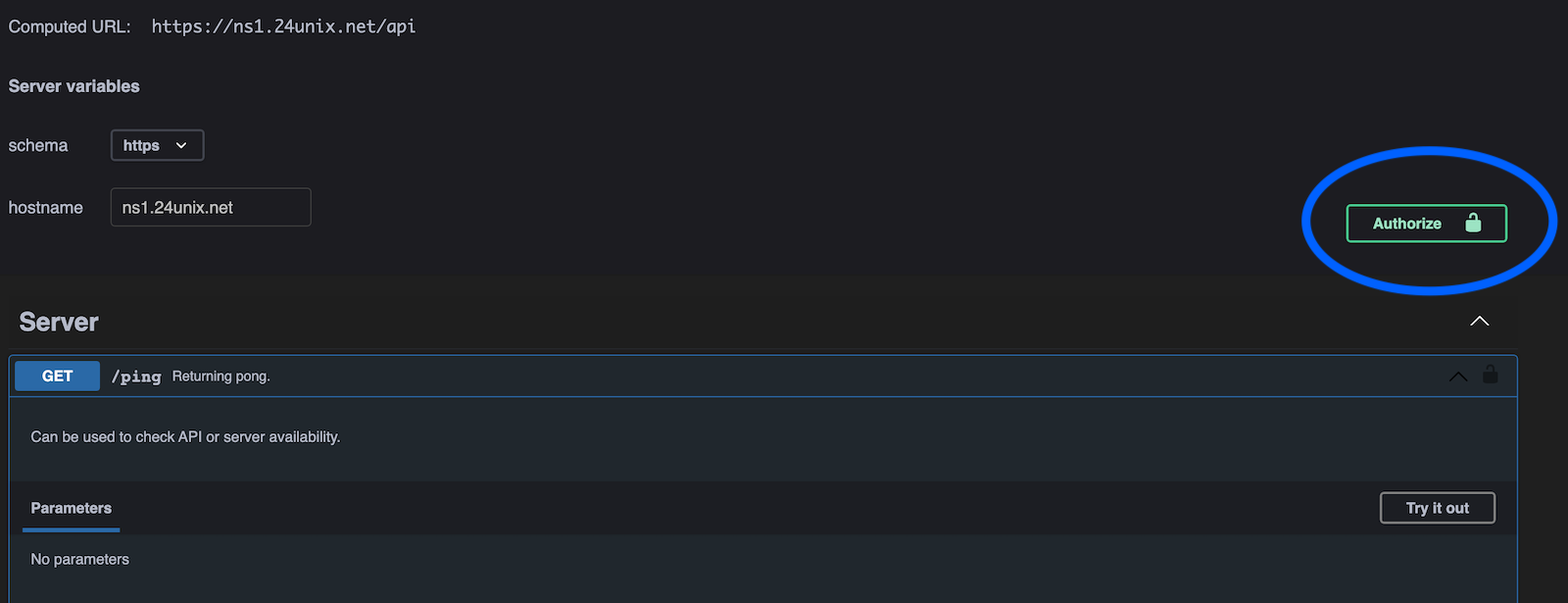
|
|
|
|
And enter you API key:
|
|
|
|
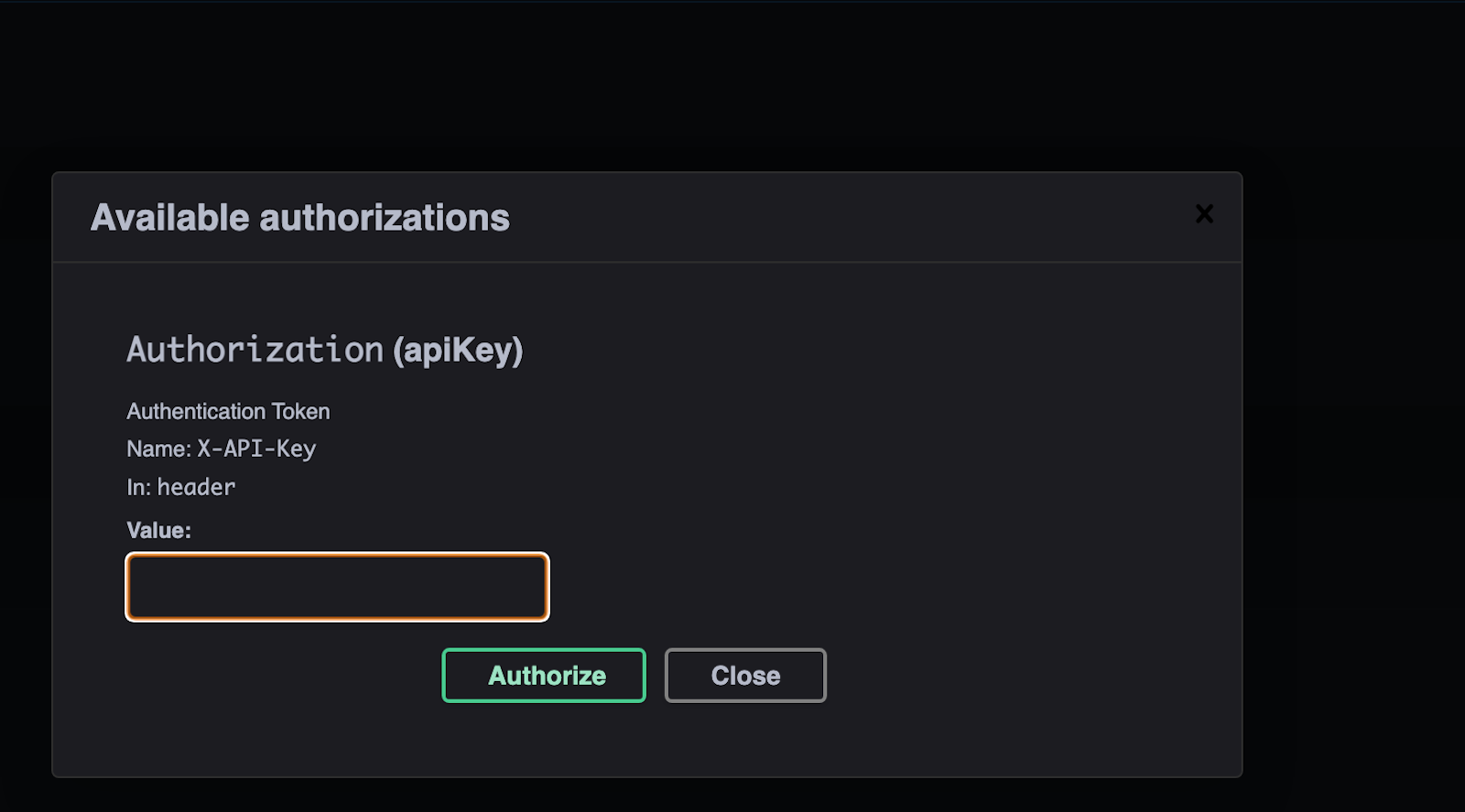
|
|
|
|
After successful authorization you can use the APi via the OpenAPI Interface, e.g. call the /ping endpoint to check if the API is alive.
|
|
|
|
You have to click on „Try it out“:
|
|
|
|

|
|
|
|
|
|
And then hit Execute:
|
|
|
|
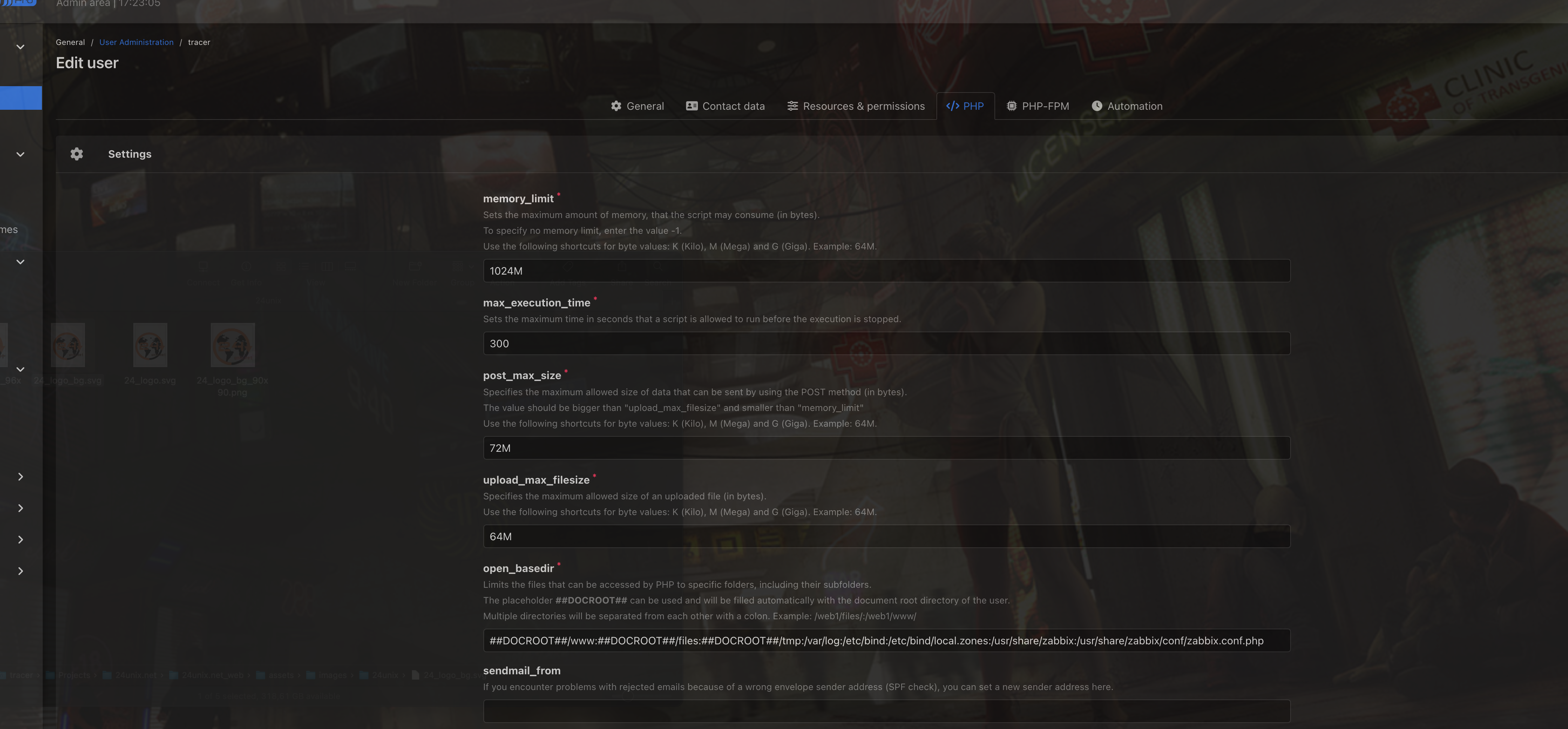
|
|
|
|
|
|
Of course, you can issue the same command in your shell:
|
|
|
|
```
|
|
curl -X 'GET' \
|
|
'https://ns1.24unix.net/api/ping' \
|
|
-H 'accept: application/json' \
|
|
-H 'X-API-Key: 61f27a57c9d1f.[truncated]'
|
|
```
|
|
|
|
A helpful tool when dealing with API is [Postman](https://www.postman.com/), if offers the same options as from the
|
|
OpenAPI interface or via shell with curl.
|
|
|
|
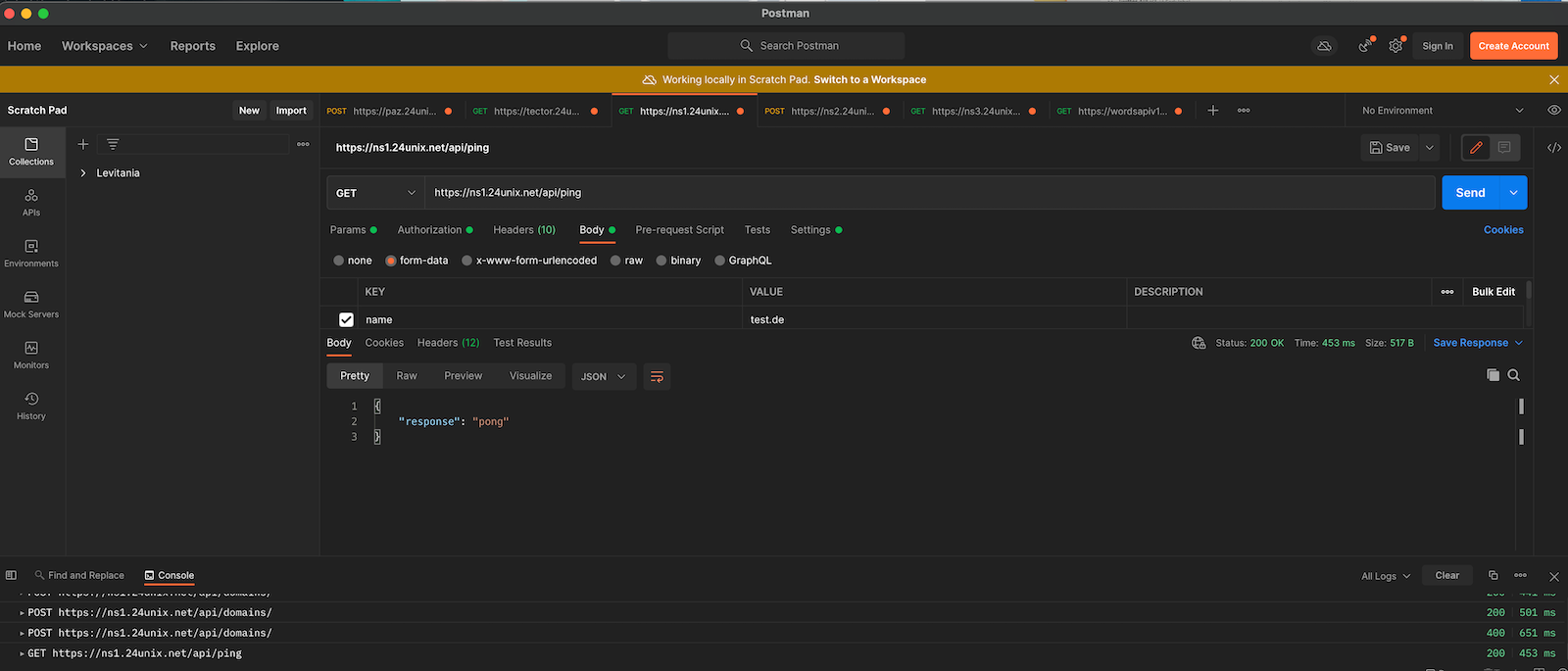
|
|
<a name="conclusion"></a>
|
|
|
|
# 6. DynDns
|
|
|
|
# 7. Conclusion
|
|
|
|
|